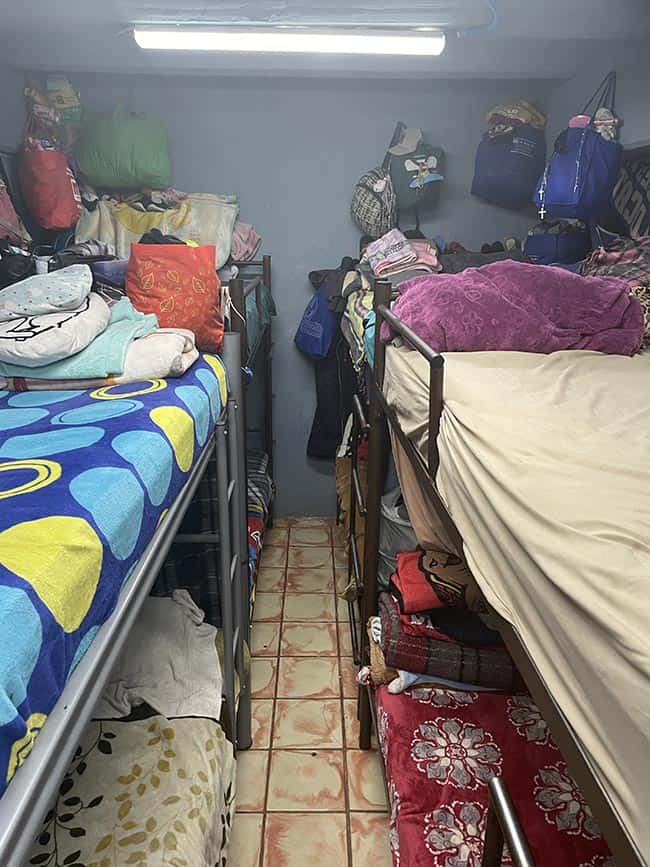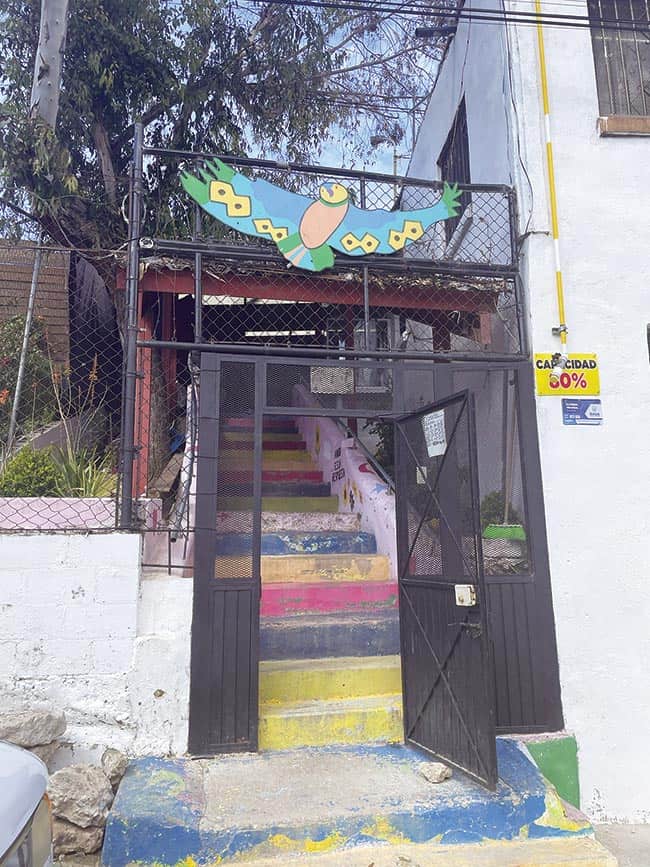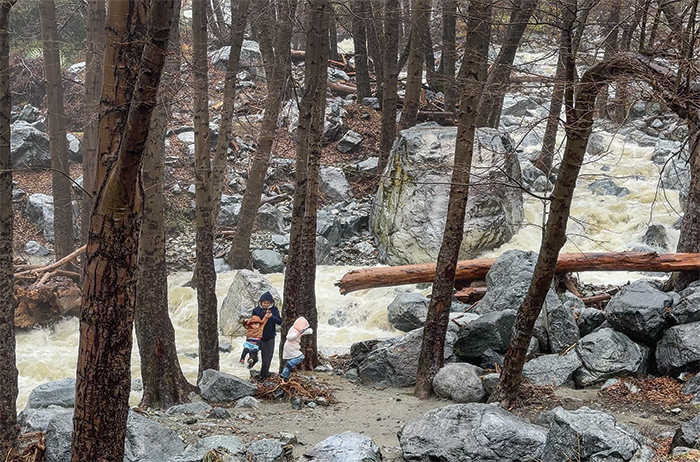A border story, part II: a light of hope

by Mick Rhodes | editor@claremont-courier.com
Leticia Herrera didn’t plan on a life of service.
Born in the northeastern Mexican state of Tamaulipas, she came to Tijuana with her father when she was a child. She grew up there in the shadow of the U.S. border, had four children, and owned a successful hair salon.
“It was a good business. I was living the good life,” she said.
Then in 2002, her youngest was killed in a car accident.
“When my son died, I let everything go, and I stopped caring about all the things I used to care about,” Herrera said.
Suddenly unmoored, she spent the next four years in a haze of grief.
“I didn’t want to leave my house. The only thing I wanted was to die. He was my youngest child, the one I loved the most.”

Leticia Herrera is the director of Por amor a Dios y a los mas necesitados, una luz de esperanza, or “For the love of God and the most needy, a light of hope,” a migrant shelter in the foothills of Tijuana, Mexico. Courier photo/Mick Rhodes
Herrera credits her Catholic faith as the thread that kept her tethered to a future. Gradually, more and more light found its way in, eventually enough that she was able to see a path forward.
“Do something that you like,” a priest told her at time.
In late 2006 Mexico’s newly elected president Felipe Calderón declared war on the country’s drug cartels. The policy shift was followed by an immediate and alarming spasm of extreme violence.
Around the same time Herrera began feeding migrants at an encampment near the Tijuana border. There had always been a steady stream of travelers heading north through Tijuana intent on entering the U.S., legally or otherwise. But the new torrent of migrants was different, Herrera said. They gave firsthand accounts of the chaos rippling through southern Mexico. Over time, more and more of them were running for their lives, unable to return home because of threats from organized crime, MS-13 gangs, and drug cartels.
Her path became clear.
Over the next decade she pulled together a homegrown network of volunteers. They began an informal food bank. It felt good to give back, almost like a calling. After spending so much time wondering why her son had to die and what she would do without him, she slowly transformed her grief into something powerful.
“It’s the better way we can pass through hard times,” Herrera said. “For me, I understand the reason my son passed away was because I have to convert myself.”

Entire families’ belongings are stored on top of the dozens of beds and sleeping pads at the Tijuana migrant shelter. Courier photo/Mick Rhodes
In the meantime, the bottleneck at the U.S./Mexico border in Tijuana degenerated from an uptick to a crisis. Still more migrants were making their way north. The need was far exceeding what Herrera could offer.
Seeing her resolve, in 2016 a Catholic priest who had nurtured her when she was at her lowest gave her the keys to a church-owned building in the foothills above Tijuana. It was in disrepair. There were three small rooms and one bathroom, making up roughly 1,300 square feet of living space. The largest area, a central courtyard, was open to the elements. Everything needed mending or upgrading. Still, it was a start. She named it Por amor a Dios y a los mas necesitados, una luz de esperanza, or “For the love of God and the most needy, a light of hope.”
The first day she was open, she fed three people.
“And then seven, and then 10, then 20,” Herrera recalled.
One day she approached the massive line of folks waiting to cross into the U.S. at the San Ysidro border; sixty people followed her back to her new shelter.
She bought, found, and solicited donations of mattresses, sleeping pads and bags, blankets, bedding, and pillows. Everyone was sleeping on the floor. The building was — and still is — without heat or air conditioning. But there was food, a bathroom, a place to wash, and a roof. Soon she was feeding 80 people or more with bought and donated food prepared on a simple, small stove.
“Then more people came,” Herrera said. “A lot of people.”
In 2017 some cartel associates heard she was helping refugees from Mexico’s LGBTQ community at the shelter and robbed her and others there. Herrera reported the theft to police. The next day the low-level cartel soldiers returned and tossed an incendiary device through an open window of one of the sleeping rooms and closed the door. Herrera and some of her neighbors managed to extinguish the blaze. The room was burned, but the shelter was standing.

The unassuming iron door leading up to Por amor a Dios y a los mas necesitados, una luz de esperanza, or “For the love of God and the most needy, a light of hope.” Courier photo/Mick Rhodes
“A lot of people thought we were going to stop working as well, but seeing [the shelter’s residents] in danger gave me a bit more strength,” Herrera said.
Things changed in 2017. Drug cartel violence, mostly in Michoacán and Guerrero, drove waves of migrants north, primarily Mexicans desperate to escape the carnage.
“Each day they get worse,” Herrera said of the cartel violence. “They are cruel. They abuse the power they have.”
The shelter was bursting at the seams.
Through donations from nonprofits, churches, and individuals — including significant contributions from a group of Claremont residents — the shelter has expanded its footprint from its 2016 beginnings. It is now roughly 3,900 square feet with several new bathrooms, a new kitchen with a commercial stove, several additional sleeping rooms, most with sturdy bunk beds, upgraded plumbing, electrical, and natural gas, and a permanent roof over its courtyard.
When the Courier visited in early March, there were 235 people staying at Por amor a Dios y a los mas necesitados, una luz de esperanza, or “Una Luz de Esperanza” for short. The courtyard served as its dining room, preschool, and catch-all town square. Rooms above and below were filled with bunk beds and sleeping pads, each with entire families’ possessions arranged neatly on top. Three desktop computers against a wall in one of the sleeping rooms offered a portal for migrants to both stay in touch with family and log in and add their names to the daily digital lottery for asylum eligibility appointments with U.S. Homeland Security personnel.
Seven years after opening, more than 13,000 people have called Una Luz de Esperanza home. Some come for a night or a week, others months at a time. It’s a waystation to be sure, but it’s safe, which is perhaps the most valuable commodity for its residents, most of whom are escaping unimaginable violence.
Against this backdrop of despair and anxiety, powerful bonds are created.
“They’re my family,” Herrera said. “For me, it’s my family, my people.”
Now 66, Herrera is Una Luz de Esperanza’s director, but also confidante and auntie to many of its travelers, the majority of whom are mothers and children. Several of the youngest children wrapped her in impromptu hugs as we toured the facility.
Word of mouth about the shelter is strong. Folks who have passed through, their families, and immigration lawyers all guide new migrants to what has turned out to be Herrera’s life’s work, all behind an unassuming iron gate in the foothills above Tijuana.
“I feel when they go to the United States, it’s like I’m leaving to the U.S.,” Herrera said. “It brings me great joy when people reunite with their families across the border.”
Hundreds of families send her photos of children, now grown and thriving, who have passed through Una Luz de Esperanza.
“They’re family now,” she said.
She said her faith in God, and in her mission — to keep safe and nurture the families navigating the increasingly labyrinthine maneuvers necessary to legally enter the U.S. — has kept her steadfast in the face of the ever-increasing violence that surrounds her.
“It’s a promise to God,” she said.
Herrera recalled the first time she stood in the building that would become Una Luz de Esperanza, in 2016. She sang a traditional Spanish children’s song, “Yo Tengo Una Casita.”
“Yo tengo una casita que es así y así
Que por la chimenea sale el humo así y así
Que cuando quiero entrar, yo golpeo así y así
Me limpio los zapatos así y así y así”
In English:
“I have a little house that is like this and like this
That the smoke comes out of the chimney like this and like this
That when I want to enter, I hit like this and like that
I clean my shoes like this and like this and like this”
“To this day, I still sing that song,” Herrera said.
Next week in Part III of “A border story,” we will learn about Claremont’s strong ties to the Tijuana shelter through residents’ donations of goods, money, expertise, time, and sweat.








0 Comments